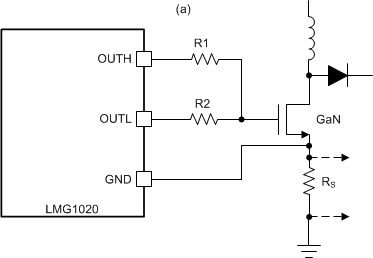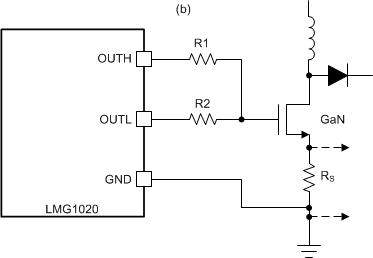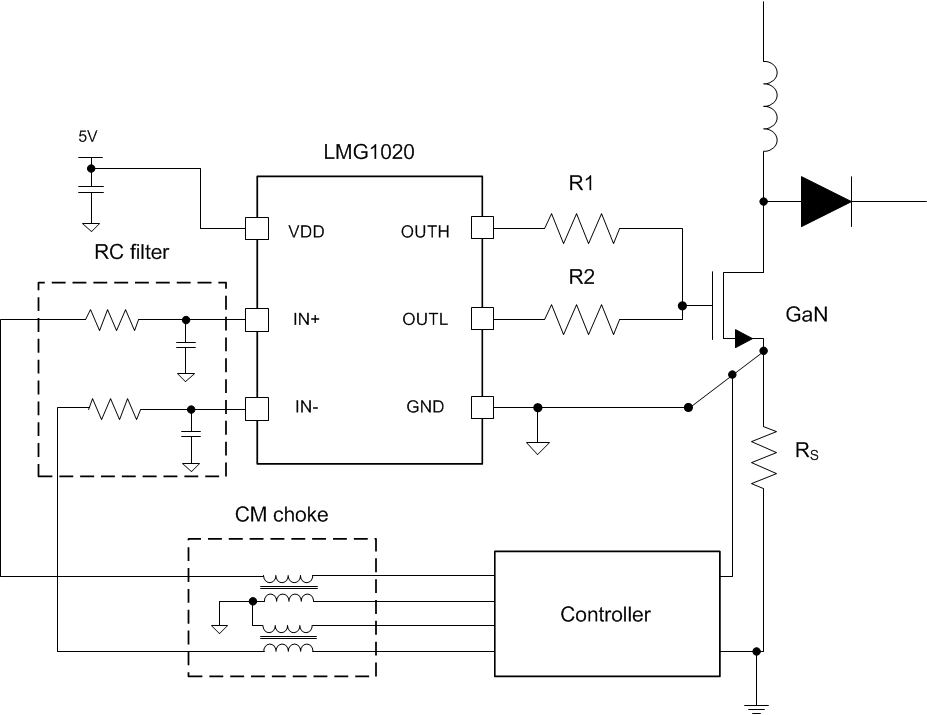ZHCSHN8B February 2018 – October 2018 LMG1020
PRODUCTION DATA.
8.2.2.1 Handling Ground Bounce
For the best switching performance and gate loop with lowest parasitics, it is recommended to connect the ground return pin of LMG1020 as close as possible to the source of the low-side FET in a low inductance manner. However, doing so can cause the ground of LMG1020 to bounce relative to the system or controller ground and lead to erroneous switching logic on the input so as mis-turn on/off on the output.
First of all, LMG1020 has input hysteresis built into the input buffers to help counteract this effect. The maximum di/dt allowed to prevent the input voltage transient from exceeding the input hysteresis is given by Equation 1

where
- LRS is the inductance between FET source and ground,
- VHYST is the hysteresis of the input pin,
- and dis/ Δt is the maximum allowed current slew rate.
For an assumed parasitic inductance of 0.5 nH and a minimum hysteresis of 0.5 V, the maximum slew rate is 1 A/ns. Many applications would exhibit higher current slew rates, up to the 10 A/ns range, which would make this approach impractical. The stability of this approach can be improved by using the IN– input for the PWM signal and locally tying IN+ to VDD. By using the inverting input, the transient voltage applied to the input pin reinforces the PWM signal in a positive feedback loop. While this approach would reduce the probability of false pulses or oscillation, the transient spikes due to high di/dt may overly stress the inputs to the LMG1020. A current-limiting, 100 Ω resistor can be placed right before the IN– input to limit excessive current spikes in the device.
Secondly, for moderate ground-bounce cases, a simple R-C filter can be built with a simple resistor in series with the inputs. By utilizing the input capacitance of LMG1020, the resistor could be close to its input pin. The addition of a small capacitor on the input as supplement can also be helpful. A small time constant of the R-C filter can can enough to filter out high frequency noises. This solution is acceptable for moderate cases in applications where extra delay is acceptable and the pulse width is not extremely short such as 1ns range.
For more extreme cases, or where no delay is tolerable while pulse width is extremely short, using a common-mode choke provides the best results.
One example application where ground-bounce is particularly challenging is when using a current sense resistor. In configuration A LMG1020 ground is connected to the source of GaN FET, while the controller ground is connected to the other side of the current sense resistor as shown in Figure 7. Due to the fast switching and very fast current slew rates, the high ground potential bounce induced by inductance of the sense resistor can disrupt the operation of the circuit or even damage the part. To prevent this, a common-mode choke can be used for IN+ and IN–, respectively. Resistors can also added to the signal output line before LMG1020 depending on the input signal pulse width to provide additional RC filtering. Figure 9 presents the schematic using approach A with the preferred filtering method. Approach B as Figure 8 places the current sense resistor within the gate drive loop path. In this case, the LMG1020 GND pin is connected to the signal ground, and with good ground plane connection, the ground bounce issue can be less severe than approach A. However, the inductance of the current sense resistor adds common-source inductance to the gate drive loop. The voltage generated across this parasitic inductance will subtract from the gate-drive voltage of the FET, slowing down the turnon and turnoff di/dt of the FET, or even cause mis-turn on and off. Additional gate resistance will have to be added to ensure the loop is stable and ring-free. The slower rise may negate the advantage of the fast switching of the GaN FET and may cause additional losses in the circuit. Therefore, this approach is not recommended.
 Figure 7. Source Resistor Current Sense A Configuration
Figure 7. Source Resistor Current Sense A Configuration  Figure 8. Source Resistor Current Sense B Configuration
Figure 8. Source Resistor Current Sense B Configuration  Figure 9. Filtering For Ground Bounce Noise Handling When Using LMG1020
Figure 9. Filtering For Ground Bounce Noise Handling When Using LMG1020